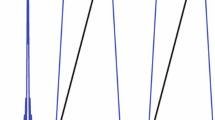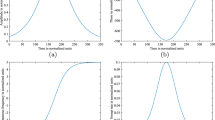Abstract
Band selective excitation is widely used in high resolution nuclear magnetic resonance (NMR) spectroscopy to suppress unwanted signals. This article proposes a simple and versatile approach to design such pulses to band selectively rotate the magnetization vector for a desired flip angle. A \(90^\circ \) excitation pulse is designed by amplitude modulation obtained using Fourier series to bring the magnetization vector to the equator of the Bloch sphere. However, this excited magnetization vector is dispersed linearly on the equator with the offset frequency. \(180^\circ \) hard pulses with a free evolution period are used to refocus the excited magnetization vector. The main advantages of this design are overall simplicity and analytical tractability, making it suitable for practical applications. Simulation for band selective excitation and band selective \(\frac{\pi }{2}\)-rotation are presented to validate the theory. Experimental realization of the proposed pulse sequences is done on a 750 MHz spectrometer for a sample of \(99.5\%\ \text {D}_2\text {O}\) and \(0.5\%\ \text {H}_2\text {O}\).











Similar content being viewed by others
Availability of data and materials:
We declare that all of the material is owned by the authors and no permissions are required.
References
J. Cavanagh, W.J. Fairbrother, A.G. Palmer, M. Rance, N.J. Skelton, Protein NMR Spectroscopy: Principles and Practice (Academic Press, Burlington, 2007)
H. Geen, R. Freeman, Band-selective radiofrequency pulses. J. Magn. Reson. 93(1), 93–141 (1991)
J. Carlson, Exact solutions for selective-excitation pulses. J. Magn. Reson. 94(2), 376–386 (1991)
J. Carlson, Exact solutions for selective excitation pulses. ii. excitation pulses with phase control. J. Magn. Reson. 97(1), 65–78 (1992)
X.-J. Miao, J.-H. Chen, X.-A. Mao, Selective excitation by radiation damping field for a coupled nuclear spin system. Chem. Phys. Lett. 304(1–2), 45–50 (1999)
E. Lescop, T. Kern, B. Brutscher, Guidelines for the use of band-selective radiofrequency pulses in hetero-nuclear nmr: example of longitudinal-relaxation-enhanced best-type 1h–15n correlation experiments. J. Magn. Reson. 203(1), 190–198 (2010)
P. Caravatti, G. Bodenhausen, R.R. Ernst, Selective pulse experiments in high-resolution solid state nmr. J. Magn. Reson. 55(1), 88–103 (1983)
K.E. Kövér, K. Fehér, L. Szilágyi, A. Borbás, P. Herczegh, A. Lipták, 2d nmr spectra of oligosaccharides enhanced by band-selective suppression of unwanted signals. Tetrahedron Lett. 41(3), 393–396 (2000)
E. Kupce, R. Freeman, Polychromatic selective pulses. J. Magn. Reson., Ser. A 102(1), 122–126 (1993)
T.J. Rutherford, K.R. Kartha, S.K. Readman, P. Cura, R.A. Field, Adaptation of an nmr signal suppression pulse sequence for the selective removal of benzylic methylene signals of benzyl ether-protected carbohydrates. Tetrahedron Lett. 40(10), 2025–2028 (1999)
R. Freeman, Selective excitation in high-resolution nmr. Chem. Rev. 91(7), 1397–1412 (1991)
R. Freeman, High resolution nmr using selective excitation. J. Mol. Struct. 266, 39–51 (1992)
J. Friedrich, S. Davies, R. Freeman, Shaped selective pulses for coherence-transfer experiments. J. Magn. Reson. 75(2), 390–395 (1987)
H. Geen, R. Freeman, Band-selective excitation for multidimensional NMR spectroscopy. J. Magn. Reson. 87(2), 415–421 (1990)
G. Bodenhausen, R. Freeman, G.A. Morris, A simple pulse sequence for selective excitation in Fourier transform NMR. J. Magn. Reson. 23, 171–175 (1976)
B.L. Tomlinson, H. Hill, Fourier synthesized excitation of nuclear magnetic resonance with application to homonuclear decoupling and solvent line suppression. J. Chem. Phys. 59(4), 1775–1784 (1973)
G.A. Morris, R. Freeman, Selective excitation in Fourier transform nuclear magnetic resonance. J. Magn. Reson. 29(3), 433–462 (1978)
D. Hoult, The solution of the bloch equations in the presence of a varying b1 field-an approach to selective pulse analysis. J. Magn. Reson. 35(1), 69–86 (1979)
P. Tekely, J. Brondeau, K. Elbayed, A. Retournard, D. Canet, A simple pulse train, using 90 hard pulses, for selective excitation in high-resolution solid-state NMR. J. Magn. Reson. 80(3), 509–516 (1988)
F. Loaiza, M. McCoy, S. Hammes, W. Warren, Selective excitation without phase distortion using self-refocused amplitude-and amplitude/phase-modulated pulses. J. Magn. Reson. 77(1), 175–181 (1988)
M. Garwood, Y. Ke, Symmetric pulses to induce arbitrary flip angles with compensation for rf inhomogeneity and resonance offsets. J. Magn. Reson. 94(3), 511–525 (1991). https://doi.org/10.1016/0022-2364(91)90137-I
T.-L. Hwang, P.C.M. van Zijl, M. Garwood, Broadband adiabatic refocusing without phase distortion. J. Magn. Reson. 124(1), 250–254 (1997). https://doi.org/10.1006/jmre.1996.1049
J.-M. Bohlen, M. Rey, G. Bodenhausen, Refocusing with chirped pulses for broadband excitation without phase dispersion. J. Magn. Reson. 84(1), 191–197 (1989). https://doi.org/10.1016/0022-2364(89)90018-8
J.M. Bohlen, G. Bodenhausen, Experimental aspects of chirp NMR spectroscopy. J. Magn. Reson., Ser. A 102(3), 293–301 (1993). https://doi.org/10.1006/jmra.1993.1107
L. Emsley, G. Bodenhausen, Volume-selective NMR spectroscopy with self-refocusing pulses. J. Magn. Reson. 87(1), 1–17 (1990)
M.R. Bendall, R.E. Gordon, Depth and refocusing pulses designed for multipulse NMR with surface coils. J. Magn. Reson. 53(3), 365–385 (1983)
M. Robin Bendall, M. Garwood, K. Uǧurbil, D.T. Pegg, Adiabatic refocusing pulse which compensates for variable of power and off-resonance effects. Magn. Reson. Med. 4(5), 493–499 (1987) https://onlinelibrary.wiley.com/doi/pdf/10.1002/mrm.1910040510. https://doi.org/10.1002/mrm.1910040510
N. Khaneja, A. Kumar, Broadband excitation by method of double sweep. Appl. Magn. Reson. 48(8), 771–782 (2017)
N. Khaneja, Chirp excitation. J. Magn. Reson. 282, 32–36 (2017). https://doi.org/10.1016/j.jmr.2017.07.003
N. Khaneja, RF-inhomogeneity compensation using method of Fourier synthesis. J. Magn. Reson. 277, 113–116 (2017). https://doi.org/10.1016/j.jmr.2017.02.010
H.S. Carslaw, A historical note on Gibbs’ phenomenon in Fourier’s series and integrals. Bull. Am. Math. Soc. 31(8), 420–424 (1925). https://doi.org/10.1090/S0002-9904-1925-04081-1
Acknowledgements
The authors are grateful to the colleagues of Sophisticated Analytical Instrument Facility (SAIF), Indian Institute of Technology Bombay for their constant support during the work. The authors sincerely thank Mr. Pramod Mali and Mr. Soumya Ranjan Pujahari for their help with the experiments. The colleagues at Department of Systems and Control Engineering and the authorities of IIT Bombay are acknowledged for their support and cooperation.
Funding
The work is funded by ‘SEED Grant’, Indian Institute of Technology Bombay.
Author information
Authors and Affiliations
Contributions
All the authors have equally contributed to this work.
Corresponding author
Ethics declarations
Conflict of interest
We declare that the authors have no competing interests as defined by Springer, or other interests that might be perceived to influence the results and/or discussion reported in this paper
Ethics approval
Not applicable
Consent to participate
Not applicable
Consent for publication
I confirm that I understand journal Applied Magnetic Resonance is a transformative journal. When research is accepted for publication, there is a choice to publish using either immediate gold open access or the traditional publishing route.
Code availability
Not applicable.
Additional information
Publisher's Note
Springer Nature remains neutral with regard to jurisdictional claims in published maps and institutional affiliations.
Rights and permissions
Springer Nature or its licensor (e.g. a society or other partner) holds exclusive rights to this article under a publishing agreement with the author(s) or other rightsholder(s); author self-archiving of the accepted manuscript version of this article is solely governed by the terms of such publishing agreement and applicable law.
About this article
Cite this article
Sarkar, S., Khaneja, N. Band Selective Excitation and \(\frac{\pi }{2}\)-Rotation using Fourier Synthesis. Appl Magn Reson 54, 699–718 (2023). https://doi.org/10.1007/s00723-023-01547-6
Received:
Revised:
Accepted:
Published:
Issue Date:
DOI: https://doi.org/10.1007/s00723-023-01547-6




